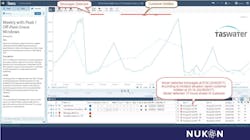Preventing sewer spillages from harming both humans and wildlife is one of the top priorities of TasWater, Tasmania’s primary water and sewage service provider. This is no small challenge since TasWater manages almost 5,000 kilometers (3,107 miles) of sewer main, and Tasmania is home to many rare species.
Midway Point, a small suburb outside of Hobart, Tasmania, is located next to Pitt Water Nature Reserve, home to rare birds, butterflies, and the largest oyster lease in Tasmania, covering some 14 hectares (about 35 acres). In late August, Pitt Water oysters, prized for their briny flavor and consistency, were just coming into peak condition.
On August 24, 2017, a customer in Midway Point reported a sewage spill on his property. Eventually 6,000 liters of wastewater were spilled into Pitt Water, contaminating oyster beds and shutting down production for three weeks. It was an ecological and economic disaster for Tasmania, which harvests 48 million oysters annually as part of a $24 million industry.
TasWater knew they needed a solution to minimize future risks. In collaboration with digital transformation consultants Nukon, TasWater began implementation of OSIsoft’s PI System as part of a pilot program to use sewage pump station (SPS) data to spot and respond to blockages and spills before they turned into ecological disasters.
What Causes Sewage Spills in Sensitive Environments?
Sewage systems and pump stations are by nature finicky assets.
“Sewage spills are an unavoidable reality of managing a sewage network,” said Matt Jordan, TasWater’s manager of network asset performance. “With the volume of our network, keeping it blockage-free is impossible.”
Tree roots cause about 70 percent of the spills and main breaks that TasWater experiences every year, but they can be predicted and prevented through root cutting, which would either involve using a mechanical auger or a hydro-jetter. The hydro-jetter can be used in conjunction with a hydraulic root cutter to cut away hard obstructions such as tree roots. The root cutter is manually attached to the end of the jetter hose, inserted in the pipe, and the pump is engaged.
“The one that really gets us is foreign objects,” said Jordan. “These are items like nappies or diapers or hand towels or Coke bottles. You name it, and it somehow ends up in the sewage system. You may have the best maintenance strategy in the world, but the day after you clean it, a foreign object can end up in there. They are the ones that are unpredictable.”
SPS Monitoring to the Rescue
Sewage pump stations have defined operating characteristics; there are peaks in pump activity at the beginning and end of the day when people are generally using more water. Utilizing analytics from Seeq, a provider of data analytics software, some of Nukon’s own tools, and the infrastructure provided by the PI System, Nukon and TasWater devised a method for identifying potential blockages.
By analyzing just a single data point — whether a pump was running or not — TasWater discovered that the “time to fill” or time between pump runs was the key determinant of a station’s operating profile. When the time between pump runs goes beyond what is normal, it suggests that the wet well (which collects the incoming water from the sewer system) is taking too long to fill and a blockage may be occurring upstream. The software will recognize these patterns and determine abnormal conditions which then creates a notification to alert staff.
First, Nukon and TasWater created models of normal pump behavior. Then, they used Asset Framework, a part of the PI Server, to set up event frames and notifications for out-of-bounds conditions.
“The notifications happen in real time, so there is no waiting around,” said Andrew May, a senior consultant at Nukon.
Had this data model been available in August 2017, the Midway Point blockage would have been detected 13 hours before it happened.
Additional Sewage Network Insights
Using the templates feature of Asset Framework, TasWater quickly expanded the pilot project from the initial pump station to all of the SPS sites in the Midway Point within a month. Currently, they track about 50,000 data points, a number that should quickly increase to over 200,000.
Though they have not yet experienced another blockage event, their data model has already given them unexpected insight into their sewage network.
For example, an increase in pump activity during a storm revealed leaky segments in the sewer system. This knowledge about the location of leaky sewers has allowed them to target funding to minimize inflow and infiltration and avoid excessive pump usage.
After their pilot program concludes, TasWater hopes to roll out their new system to all of their pump stations located in sensitive areas, in turn expanding their ability to protect the health and safety of their customers, the environment, and of course, those delicious oysters.
“We’re hopeful this program can be used wherever our assets are in high risk areas … and help TasWater work more responsively with shellfish growers for better outcomes,” Alexander Jovcic, TasWater department manager of service optimization said. WW
About the Author

Gary Wong
Gary Wong is the Principal, Global Water Industry at OSIsoft, a leader in real-time operational intelligence. He has over 20 years of extensive international experience providing sustainable, strategic and cost-effective business solutions in the water industry. Prior to joining OSIsoft, he has held positions with Metro Vancouver and as a consultant directing both public and private sectors on Operations, IT strategy, planning, sustainability, and engineering. Mr. Wong is also the Chairman of the Smart Water Networks Forum (SWAN) Americas Alliance and holds a Bachelor’s Degree in Chemical Engineering, is registered as a Professional Engineer in Computer Engineering, holds an M.B.A. from the Queen’s School of Business and is also a Chartered Professional Accountant.

